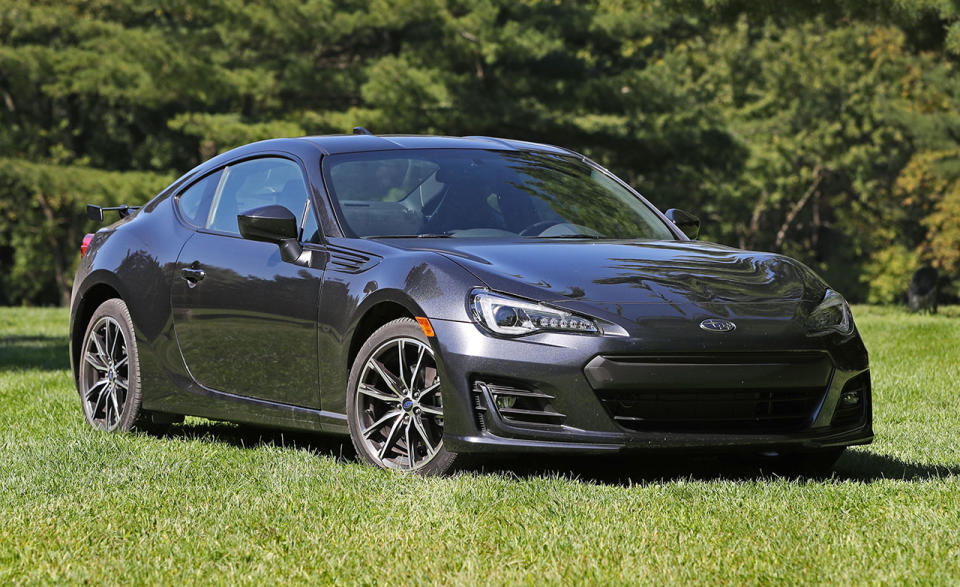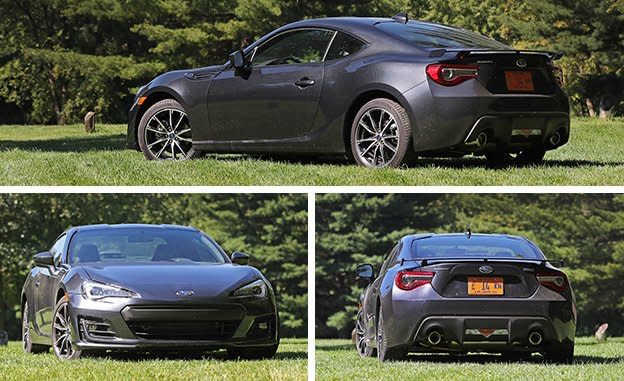2017 Subaru BRZ Manual

That Subaru’s 2017 BRZ should come with a turbocharged version of the company’s 2.0-liter flat-four FA engine, like the one that makes 268 horsepower in its WRX sedan, is a foregone conclusion. After four years of sameness, the too-buzzy, too-slow BRZ was beginning to look like the sports coupe the world had forgotten.
But the potential-laden coupe was due for a refresh, and Subaru had to do something. Imagine its predicament, then: Do they engineer a solution to the packaging problem that supposedly prevents fitting the turbocharged FA engine in the BRZ’s nose, or do they revise its naturally aspirated engine to make more power? Subaru representatives say that the primary concerns about the BRZ are a low center of gravity, balanced handling, and low cost, and those preclude fitting the turbocharged engine. We say the car’s desperate need for more power and giant-killer potential outweigh all of those priorities. And we’d wager that we’re not the only ones who’d pay more for a boosted BRZ with wider tires and a stiffer suspension.

Plus, making the turbo engine fit can’t be quite as big an obstacle as Subaru claims. After all, the company has been packaging turbos in space-compromised engine bays for more than 20 years with huge success. And a turbo would cure two of the BRZ’s greatest vices: a lack of low-end torque and the need to spin its engine to 7000 rpm, where it’s thrashy and loud but still not especially powerful. So what did Subaru do?
It persisted, boost-free.
A Lot of Work for a 0.1-Second Gain
We give you the 2017 Subaru BRZ with a heavily revised but still naturally aspirated 2.0-liter flat-four. Equipped with new intake and exhaust manifolds, cylinder heads, cams, and valves, its power climbs from 200 to 205 horsepower while peak torque rises an equally insignificant 5 lb-ft, to 156 lb-ft. The gains appear so high in the rev range (peak output is at 7000 and 6400 rpm, respectively) as to be virtually imperceptible in daily driving. And the torque valley that haunts the BRZ’s midrange, between 3300 and 4600 rpm? It is slightly mitigated but still exists and is still burdensome. It’s a character killer in a car that’s otherwise full of promising personality.

What’s more, these increases only apply to cars equipped with the six-speed manual transmission. The BRZ with six-speed automatic is rated, same as last year, at 200 horsepower and 151 lb-ft of torque. Manual-transmission BRZs also benefit from a shorter final-drive ratio (4.30:1 vs. 4.10:1) that gives the low-torque engine better leverage over the tires.
Predictably, a 5-hp gain and marginally shorter gearing do little to improve measured performance. Our 2017 test car hit 60 mph in 6.2 seconds and covered the quarter-mile in 14.8 seconds—improvements of 0.1 second across the board relative to the last manual BRZ we tested, a 2016 model. Trap speed remained the same at 95 mph. That slight boost in straight-line performance also comes with a penalty at the pump, with the manual BRZ now EPA rated at 21 mpg city and 28 mpg highway, down from last year’s 22/30 mpg. We weren’t able to record a real-world figure for this BRZ, but a similar 2017 Toyota 86 we tested at the same time returned a 23-mpg average.
Stiffening at the front strut mounts and rear damper mounts, coupled with retuned spring rates plus a larger rear anti-roll bar, yield only subtle improvements in road driving. Even at its limits, most drivers would find the changes every bit as hard to detect as that tenth of a second in the quarter-mile. Even so, the BRZ’s steering response, overall balance, and compact packaging encourage hard driving in ways that other coupes at this price simply do not. At 0.90 g on the skidpad, the BRZ doesn’t break any grip records. Blame the modest 215/45R-17 Michelin Primacy HP rubber, not the chassis, which boasts frustratingly underutilized potential.

Our test car lacked the $1195 Performance package, which adds Brembo four-piston front and two-piston rear calipers in addition to larger rotors at both ends. The standard brakes stopped the car in 164 feet from 70 mph, nearly identical to the previous BRZ.
Meaningless Change
Bottom line? There’s no meaningful performance gain to be had for Subaru’s rather significant massaging of the BRZ. Fortunately, the changes come with an equally inconsequential $125 increase in base price. Our test car was a Limited trim model with no options. Picking the Limited, rather than the base Premium, upgrades the seats and interior trim and adds dual-zone climate control and remote keyless entry with a proximity key. Even so, the price stays below the $30,000 mark. Yet, although it remains among the most entertaining cars at that price, its lack of underhood soul makes Chevy’s Camaro V-6 or Ford’s EcoBoosted Mustang, both of which are quicker, look awfully tempting for about the same money.
At this rate, the BRZ and its counterpart, the Toyota 86, are destined to suffer the same fate as the late Nissan 240SX—another coupe with a fantastic chassis that desperately needed an engine to match. The Nissan died at the hands of bean counters disgruntled about low sales volume. The benefits a turbocharged engine would bestow on the BRZ are too great to ignore, both for driving enthusiasts and for its longevity. Are you listening, Subaru?
Specifications >
VEHICLE TYPE: front-engine, rear-wheel-drive, 4-passenger, 2-door coupe
PRICE AS TESTED: $28,465 (base price: $26,315)
ENGINE TYPE: DOHC 16-valve flat-4, aluminum block and heads, port and direct fuel injection
Displacement: 122 cu in, 1998 cc
Power: 205 hp @ 7000 rpm
Torque: 156 lb-ft @ 6400 rpm
TRANSMISSION: 6-speed manual
DIMENSIONS:
Wheelbase: 101.2 in
Length: 166.7 in
Width: 69.9 in Height: 50.6 in
Passenger volume: 80 cu ft
Cargo volume: 7 cu ft
Curb weight: 2777 lb
C/D TEST RESULTS:
Zero to 60 mph: 6.2 sec
Zero to 100 mph: 16.3 sec
Rolling start, 5–60 mph: 7.2 sec
Top gear, 30–50 mph: 10.6 sec
Top gear, 50–70 mph: 8.6 sec
Standing ¼-mile: 14.8 sec @ 95 mph
Top speed (drag limited): 134 mph
Braking, 70–0 mph: 164 ft
Roadholding, 300-ft-dia skidpad: 0.90 g
FUEL ECONOMY:
EPA city/highway driving: 21/29 mpg

 Yahoo Autos
Yahoo Autos 